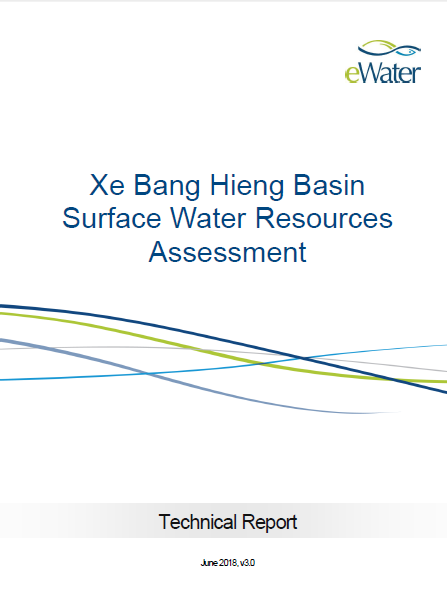Water plays an essential role in the life and culture of the Lao people. More than a third of GDP and 75% of total employment are from the subsistence agriculture, which is heavily reliant on rainfall and fluvial water resources. Lao PDR accounts for more than 20% of the overall Mekong drainage and about 80% of the country’s area lies within Mekong River Basin. Traditionally, Lao PDR was considered a water-rich country, and water quality is generally good. The situation, however, is changing. The demand on water resources has grown; the competition between water users has increased, especially in the dry season; climate change may affect water quality due to higher temperatures and may decrease stocks and impact the water infrastructure due to increased flash flood events. The new situations are challenging traditional concepts and require policies that integrate water into national socio-economic development and balance economic and environmental outcomes/needs among local, national and international interests.
In response to these challenges, the government of Lao PDR has developed a National Water Resources Strategy and Action Plan 2016-2020 (NWRSAP), which provides guidance and instruments for sustainable water resource management and promotes a holistic and integrated approach. In conjunction, the amended Water and Water Resources law in Lao PDR was approved in 2017. The new law focusses on better protection of water and water resources for sustainable use, as well bringing the law in line with the national economic development.
The World Bank’s Mekong Integrated Water Resources Management (MIWRM) program is supporting the Lao PDR government to establish examples of integrated water resources management (IWRM) practices at the regional, river basin and local levels. As part of the MIWRM program, eWater is supporting the Loa PDR Natural Resources and Environment Research Institute (NRERI) Hydrological Modelling Unit to build its capacity to develop and apply water models for better assessment of water resources, optimal and sustainable water resource management and the support of water related decision-making processes in Lao PDR.
The Xe Bang Fai Basin is located in southern Lao PDR and is a sub-basin of the Mekong River Basin, The headwaters of the Xe Bang Fai are located on the border between Lao PDR and Vietnam. The river is approximately 350 km in length and has a catchment area of 9,708 km2. Two major tributaries of the Xe Bang Fai are the Nam Ou La and Se Noy. With a median elevation of 223 m above mean sea level (amsl) and a median slope of 4%, the Xe Bain Fai Basin can be described as a generally low and flat river basin. However, the northern and eastern parts of the basin are characterised by parallel upland areas, with rocky outcrops.
The Xe Bang Hieng Basin is located in southern Lao PDR and is a sub-basin of the Mekong River Basin. The headwaters of the Xe Bang Hieng are located in Vietnam. The Annamite Ranges form the watershed boundary between the rivers flowing west in the Mekong Basin and those flow east toward the Vietnam coastline. The river is approximately 360 km in length and has a catchment area of 19,543 km2, approximately 3.5% of this area being in Vietnam. There are five main tributary sub-basins in the Xe Bang Hieng basin and these are the Se Champhone, the Se Xangxoy, the Se Ta Mok, the Se Lanong and the Se Pon. With a median elevation of 236 m above mean sea level (amsl) and a median slope of 3%, the Xe Bang Hieng Basin can be described as generally low and flat
The Xe Don Basin is located in southern Lao PDR. The Xe Don mainstream is approximately 250 km in length and has a catchment area of 7,174 km2. It joins the Mekong River near Pakse. Three major tributaries of the Xe Don are the Xe Kon, the Xe Set and the Houay Champi. With a median elevation of 244 m above mean sea level (amsl) and a median slope of 2%, the Xe Don Basin can be described as a generally low and flat. Elevations range from between 91 m and 1684 m amsl.
The Xe Kong Basin is located in southern Lao PDR and has an area of 29,000 km2. The Xe Kong River joins with the Sesan and Srepok Rivers to form the 3S River Basin, a major sub-basin of the Mekong River system that contributes around 20% of the Mekong’s annual discharge. The Xe Kong Basin spans three countries, with the majority (77.5%) of the basin situated in Laos, 2.5% in Vietnam and 20% in Cambodia. The Xe Kong River is approximately 400 km in length. It rises in Vietnam and flows through southern Laos to finally join with the Mekong River in Cambodia. Major tributaries of the Xe Kong include the Xe Kaman and the Xe Xou. The Xe Kong Basin ranges in elevation from 42 to 2,192 m above mean sea level (amsl), with a median elevation of 441 m amsl,. The basin is noted for its rugged topography, and has a median slope of 8%.
Can Download Report on Publication Manu at Webpage


